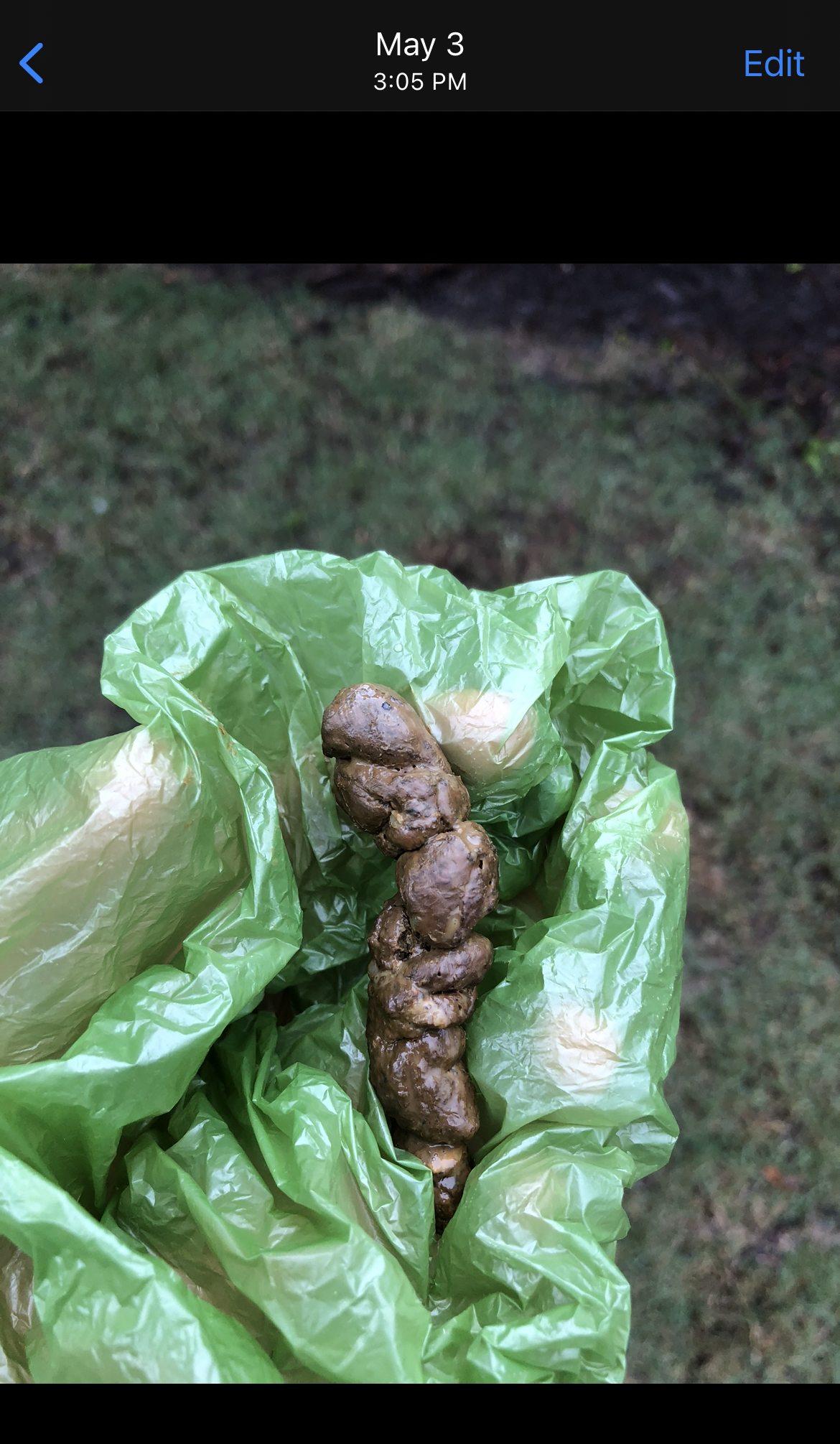Seeing something unusual in your dog’s poop can be alarming. If you’re worried it might be Giardia, this guide will help you understand what Giardia might look like in dog poop, along with other important symptoms, diagnosis, and treatment options. We’ll also cover natural remedies and prevention strategies, emphasizing the crucial role of your veterinarian in ensuring your dog’s health.
Decoding Your Dog’s Droppings: Is it Giardia?
So, you’re searching for a “giardia dog poop picture“? It’s natural to want a visual confirmation, but Giardia is a tricky parasite. While images can provide a general idea, they aren’t a reliable diagnostic tool. Giardia in dog poop can appear surprisingly normal, making it tough to spot visually. Dive into the fascinating world of an ecosystem that rivals rainforest and uncover its hidden wonders.
What Might Giardia-Infected Poop Look Like?
Giardia is a master of disguise. It can cause a range of changes in your dog’s stool, or sometimes none at all! It might appear soft, watery, or even a bit greasy. You might also notice a greenish tinge, but color isn’t a definitive indicator. Sometimes, infected stool looks just like regular stool, highlighting the importance of considering other symptoms.
Beyond the Poop: Other Telltale Signs
Diarrhea is a common symptom, but its severity varies. Some dogs may have slightly soft stools, while others experience profuse, watery diarrhea. Some dogs with Giardia don’t show any digestive upset, yet can still spread the parasite, underscoring the importance of hygiene.
Besides diarrhea, watch for these potential signs:
- Weight loss: Is your dog losing weight without changes in diet or exercise?
- Lethargy: Is your usually energetic pup unusually tired?
- Discomfort: Is your dog acting “off” or showing signs of abdominal discomfort?
If you observe any of these signs, consult your veterinarian.
Why Pictures Aren’t Enough: The Importance of a Vet Visit
A giardia dog poop picture offers a starting point, but it’s not a diagnosis. At-home tests exist, but their accuracy can vary. Your veterinarian can perform a fecal flotation test, the gold standard for diagnosing Giardia, allowing microscopic identification of the parasites.
Treatment: Partnering with Your Veterinarian
If your dog has Giardia, avoid self-treating. Even natural remedies can be harmful if misused. Your vet will likely prescribe antiparasitic medication. They’ll also advise on managing symptoms and preventing reinfection.
Preventing Giardia: Hygiene is Key
Giardia spreads easily. Proper poop disposal is crucial. Scoop immediately and dispose of it responsibly. Ensure your dog has clean, fresh water, avoiding potentially contaminated sources. Regular handwashing is vital for both your dog’s and your health, as Giardia can be transmitted to humans.
The Risks of Untreated Giardia
Ignoring Giardia can lead to chronic digestive problems, affecting your dog’s overall health. Early diagnosis and treatment are essential.
Visual Comparison: Giardia-Positive vs. Normal Stool
| Feature | Giardia-Positive Stool | Normal Stool |
|---|---|---|
| Appearance | May appear normal, soft, watery, greasy, or greenish | Typically firm, consistent in shape |
| Consistency | Can range from soft to watery, sometimes mucousy | Formed and solid |
| Color | Often yellowish-brown, sometimes with a green tinge | Typically brown |
| Smell | May have a stronger, more unpleasant odor | Usually a typical, musky dog stool odor |
What Naturally Kills Giardia? Exploring Natural Options and Prevention
While conventional veterinary treatment is essential for Giardia, some natural approaches may support your dog’s recovery and help prevent future infections. Remember: always consult your veterinarian before starting any new treatment, including natural remedies.
Natural Remedies: Potential Allies in the Fight Against Giardia
Some natural substances show promise against Giardia. Oregon grape and goldenseal contain berberine, which may have antiparasitic properties. Cloves and garlic also contain antimicrobial compounds, potentially inhibiting Giardia’s growth. However, these can be toxic to dogs in large doses. Your vet can advise on safe dosages and suitability.
Environmental Control: Breaking the Cycle of Infection
Sunlight is a natural disinfectant. Direct sunlight can kill Giardia cysts on surfaces. Similarly, steam cleaning and common disinfectants are effective, but follow instructions carefully. By eliminating the parasite from your dog’s environment, you disrupt the cycle of infection.
Prevention: The Best Defense
Preventing Giardia primarily involves good hygiene:
- Scoop your dog’s poop immediately.
- Wash your hands thoroughly after handling pet waste.
- Provide clean, fresh water, avoiding stagnant sources.
These precautions can significantly reduce your dog’s risk.
Supporting Gut Health: A Proactive Approach
A healthy gut is more resilient to infections. Prebiotics and probiotics may support gut health and potentially aid in Giardia recovery by encouraging beneficial bacteria. While research is ongoing, some studies suggest certain probiotic strains might reduce symptom severity and duration. Consult your vet before adding these to your dog’s diet, as effectiveness can vary.
Symptoms and Diagnosis: A Closer Look
Giardia symptoms can be variable, ranging from watery, sometimes greenish or greasy diarrhea, to vomiting, weight loss, and lethargy. Frustratingly, some dogs are asymptomatic. This is why veterinary diagnosis, through a fecal test, is crucial for accurate detection of Giardia cysts.
Long-Term Effects and Management: A Collaborative Approach with Your Vet
Untreated Giardia can lead to chronic digestive problems. Early diagnosis and treatment are essential. Your vet will likely prescribe an antiparasitic medication. Follow their instructions and complete the full course, even if symptoms improve sooner. This ensures complete eradication and minimizes reinfection risk.
How Long Does Giardia Last in Dogs? Understanding the Timeline and Prevention
With proper treatment and diligent cleaning, most dogs recover from Giardia within 7-10 days. However, even after symptoms resolve, Giardia cysts can persist in their poop for several months. Maintaining a rigorous cleaning routine is vital to prevent reinfection.
Treatment typically involves a multi-pronged approach:
- Medication: Your vet will prescribe medication to target the parasite.
- Environmental Disinfection: Thorough cleaning of your dog’s surroundings is essential to eliminate lingering cysts.
- Bathing: A bath on the last day of medication helps remove any remaining cysts from your dog’s fur.
Prevention focuses on:
- Clean Water: Provide fresh, clean drinking water and avoid questionable sources.
- Poop Patrol: Scoop your dog’s poop immediately, especially in public areas.
- Hygiene: Wash your hands thoroughly after handling your dog or their waste.
If diarrhea persists or worsens after 7-10 days of treatment, consult your vet. It could indicate reinfection, another health issue, or drug resistance.
Ongoing research continues to expand our understanding of Giardia. Some breeds may be more susceptible, and new treatments are being explored. If you have any questions or concerns, consulting your vet is always the best course of action for tailored advice.
- Red Cloud, NE: Discover Willa Cather’s Legacy - April 11, 2025
- Remember Old Social Media Sites? Their Rise and Fall - April 11, 2025
- How many days till Feb 3?Accurate Countdowns & Tools - April 11, 2025
















